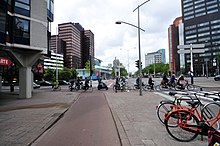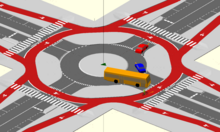Protected intersection

A protected intersection is a street junction at ground level where cyclists and pedestrians are separated from motor traffic . Vehicles turning right (in countries that drive on the right-hand side or on the left in countries that drive on the left-hand side) are separated by a vehicle length from crossing cyclists and pedestrians, which leads to increased reaction time and visibility. Drivers who want to turn right have a better view of cyclists and pedestrians because they can look to the side to avoid conflict instead of looking over their shoulders.
This type of crossing is common in the bike-friendly Netherlands . Several other countries and administrative areas have started creating protected intersections similar to those in the Netherlands, including the U.S. cities of Salt Lake City , Austin, Davis, and Boston, and the Canadian cities of Ottawa , Vancouver, and Waterloo .
features
A number of features make this crossing safer. A traffic island on the corner; a recessed crossing for pedestrians and cyclists, generally recessed between 1.5 and 7 meters; a front stop line that allows cyclists to stop at a traffic light well in front of the traffic that has to stop behind the zebra crossing. In order to avoid conflicts between cars and cyclists and pedestrians or to give them a head start over motorized traffic, a separate traffic light circuit or at least a green for cyclists and pedestrians is used. In many cases the design allows cyclists to turn right on red without stopping, and sometimes left turn on red, depending on the geometry of the intersection.
Clear ground marking is crucial to define the fact that the cycle path has priority over other traffic. Wide stripes are painted on the side of the cycle path and "shark teeth" (triangles with pointed ends that are aligned with the non-priority vehicles) are used to remind right-turning motorists that cyclists have priority and are sometimes used at the entrance to the Lane used at the intersection.
In addition to the floor markings , the color of the cycle path plays a role in order to make the cyclist's priority clear. In the Netherlands, the red color of the cycle path is not painted on the surface, but rather embedded in the asphalt to increase durability and reduce maintenance costs.
Often times, the cycle path at the intersection is raised slightly to invite drivers to reduce their speed.
Cyclists ideally have a protected cycle path at the intersection, which is separated by a concrete central barrier if possible, and a protected cycle path width of at least 2 meters, if possible (one direction). Most one-way cycle paths in the Netherlands are at least 2.5 meters wide.
A smaller radius could increase the turning problems for larger vehicles (trucks and buses), so in some cases partially "climbable" islands have been developed, similar to the central island of a small roundabout .
Protected roundabouts
Protected roundabouts are a variation of protected intersections for reduced traffic without traffic lights.
An alternative construction with greater distance from the intersection for bicycle and pedestrian crossings and motorists who have priority over cyclists could be safer and more practical if the cycle path is in both directions.
Individual evidence
- ↑ https://altaplanning.com/wp-content/uploads/Evolution-of-the-Protected-Intersection_ALTA-2015.pdf
- ^ Why Salt Lake City Chose to Build the First Protected Intersection for Bicycling in the US . Retrieved July 10, 2015.
- ↑ FOUR US CITIES ARE RACING TO OPEN THE COUNTRY'S FIRST PROTECTED INTERSECTION . Retrieved July 10, 2015.
- ↑ Out of the Box Transcript.docx (PDF) Retrieved April 4, 2018.
- ↑ How wide is a Dutch cycle path? | BICYCLE DUTCH . Bicycledutch.wordpress.com. October 1, 2015. Retrieved April 4, 2018.
- ↑ Video: Dutch roundabout and blog post on the Youtube Chain and web site 'BicycleDutch'
- ↑ David Hembrow 2014 post about safer roundabouts , with 2018 update and statistics

